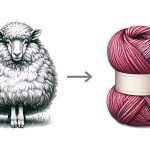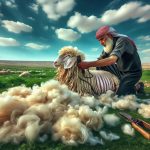Hey there! Have you ever wondered what color wool comes in? Wool is a versatile natural fiber that can come in a range of colors, from creamy whites to deep browns and even vibrant blues and greens.
In this article, we’ll explore the natural colors of wool, the science behind wool color, the history of wool dyeing, and the range of dyed wool colors available today.
Did you know that the color of wool can actually tell you a lot about the sheep it came from? The natural colors of wool can vary depending on the breed of sheep, their diet, and even their environment.
Understanding the science behind wool color can help you appreciate the unique qualities of this natural fiber. Whether you’re a fashion designer, a textile artist, or just someone who loves wool, this article will give you a deeper appreciation for the colors of this incredible material.
So sit back, grab a cup of tea, and let’s explore the world of wool color together!
Table of Contents
The Natural Colors of Wool
The beauty of wool lies in its natural colors, which can vary from creamy whites to rich browns and grays. Unlike synthetic fibers, wool comes in a range of colors that are not created in a lab.
The natural colors of wool are determined by the breed of sheep, their diet, and the climate they live in. Sheep from colder climates tend to have darker wool, while those from warmer climates tend to have lighter wool.
For example, the Merino sheep, which is native to Spain, produces wool that is often creamy white or light beige. On the other hand, the Shetland sheep, which is native to the Shetland Islands in Scotland, produces wool that can be black, gray, or brown. The natural colors of wool can also vary within a single breed of sheep.
This is because the sheep’s diet can affect the color of their wool. For example, if a sheep eats a lot of grass, their wool may be a brighter shade of green. Additionally, sheep that live in higher altitudes may have wool that is darker or richer in color.
Overall, the natural colors of wool are a testament to the versatility and beauty of this natural fiber.
The Science of Wool Color
Imagine yourself admiring the stunning hues of a cozy sweater you’ve just purchased. Did you know that the color of wool is determined by a complex interplay of genetics, environment, and processing techniques?
Wool is made up of the protein keratin, and the color of wool fibers is determined by the amount and type of pigments present in the sheep’s skin and hair follicles. The genetics of the sheep play a significant role in determining the color of wool, and certain breeds are more likely to produce particular colors.
The environment in which the sheep live can also affect the color of their wool. Sunlight, water, and temperature can all influence the production of pigments in the skin and hair follicles of the sheep.
Additionally, the processing techniques used to turn raw wool into yarn or fabric can affect the color of the final product. Chemical treatments, dyeing, and blending different colors of wool can all alter the original color of the fiber.
Understanding the science of wool color can help you appreciate the unique characteristics of this versatile natural fiber. From the subtle variations in natural wool colors to the vibrant hues created through dyeing and blending, wool offers a wide range of possibilities for creating beautiful and functional textiles.
Whether you’re knitting a cozy sweater or weaving a colorful rug, the science of wool color adds an extra layer of interest and intrigue to this wonderful material.
The History of Wool Dyeing
Throughout history, people have used a variety of plant and animal-based dyes to add vibrant hues to their wool textiles. In fact, the art of dyeing wool dates back thousands of years.
The ancient Egyptians, for example, used madder root, indigo, and saffron to dye their wool fabrics. Over time, various cultures developed their own methods and techniques for dyeing wool.
The Greeks, for instance, used a combination of indigo and woad to create a deep blue color, while the Romans favored shades of purple made from a type of shellfish. In the Middle Ages, wool dyeing became a highly specialized craft, with guilds and trade secrets governing the production of certain colors.
Today, wool dyeing is still a thriving industry, with many artisans and textile companies experimenting with natural and synthetic dyes to produce an endless array of colors. From rich jewel tones to muted earthy hues, the possibilities are endless when it comes to dyeing wool.
Whether you’re a fashion designer, textile artist, or just someone who appreciates the beauty of this versatile natural fiber, there’s no denying the importance of color in the history and future of wool.
The Range of Dyed Wool Colors
As you explore the range of dyed wool colors, you’ll find that there are three key categories: primary colors, pastels and neutrals, and bold and vibrant hues.
Primary colors like red, yellow, and blue are the building blocks of all other colors and can be mixed to create a wide range of shades.
Pastels and neutrals like soft pinks, grays, and browns provide a more subdued palette.
Bold and vibrant hues like hot pink, electric blue, and neon green make a statement.
Primary Colors
You can mix the primary colors of red, blue, and yellow to create a wide range of shades and hues in wool fibers. These colors are called primary because they can’t be created by mixing other colors together.
When you combine them, you can get secondary colors like purple, green, and orange. By mixing different amounts of each primary color, you can create an infinite number of shades and tones in wool.
When dying wool, it’s important to keep in mind that the base color of the wool will affect how the dye appears. For example, a yellow base wool will produce warmer shades of orange and green, while a blue base wool will produce cooler shades of purple and green.
Experimenting with different combinations of primary colors can lead to beautiful and unique colors in wool fibers. So, grab some red, blue, and yellow dye and start mixing!
Pastels and Neutrals
To achieve a soft and understated look, try mixing in some pastels and neutrals when dyeing your wool fibers. Pastel colors, such as light pink, baby blue, and lavender, can add a delicate touch to your wool creations. These colors are achieved by diluting primary colors with white, creating a softer hue. Neutrals, such as beige, gray, and taupe, can add a sophisticated and timeless look to your wool projects. These colors are achieved by mixing primary colors together, creating a subdued shade.
To help you better understand the different pastel and neutral colors that can be achieved with wool, here is a table showcasing some popular color combinations:
| Pastel Colors | Neutral Colors |
|---|---|
| Light Pink | Beige |
| Baby Blue | Gray |
| Lavender | Taupe |
Mixing these colors with your wool fibers can create a variety of beautiful shades and tones. Experiment with different ratios of primary colors and white or mixing different primary colors together to achieve your desired pastel or neutral color. Don’t be afraid to get creative and play with different color combinations!
Bold and Vibrant Hues
Get ready to make a statement with bold and vibrant hues in your next wool project! Wool is a versatile natural fiber that can be dyed in a wide range of colors, from soft pastels to bold and bright shades.
If you’re feeling adventurous and want to add a pop of color to your wardrobe or home decor, here are some ideas to get you started:
- Opt for a bold red wool sweater to make a statement and add warmth to your outfit.
- Incorporate a bright yellow wool throw pillow into your living room decor for a playful touch.
- Use a vibrant blue wool yarn to knit a cozy scarf that will brighten up any winter day.
- Go for a daring emerald green wool coat to stand out in a sea of black and grey outerwear.
With so many colorful options, there’s no limit to what you can create with wool. Don’t be afraid to experiment and have fun with different shades and combinations. Let your personality shine through every stitch!
In addition to being visually striking, bold and vibrant wool hues are also a great way to uplift your mood and add a touch of cheer to your day. Whether you’re feeling down or simply want to add some extra color to your life, incorporating bright wool pieces into your wardrobe or home decor can make a big difference.
So why not embrace the power of color and let wool be your canvas for self-expression?
The Art of Wool Dyeing
So, you want to know more about the art of wool dyeing? Well, let’s start with the basics.
There are two types of dyes used in wool dyeing: natural and synthetic. And when it comes to the actual dyeing process, there are a variety of hand-dyeing techniques that can be used to achieve different effects.
Are you ready to dive in and explore this colorful world?
Natural Dyes
You can achieve a range of beautiful hues with natural dyes, which are derived from sources such as plants, insects, and minerals. These dyes are not only environmentally friendly, but also provide a unique and vibrant color palette. Depending on the source of the dye, wool can take on a variety of shades, from soft pastels to deep, rich colors.
Plant-based dyes, such as indigo and madder, are some of the most commonly used natural dyes for wool. Indigo produces a deep blue color, while madder can create shades of red and orange. Insects like cochineal can produce a bright red dye, and minerals like iron can create gray or black shades.
Experimenting with different natural dyes can lead to a world of color possibilities for your wool projects.
Synthetic Dyes
Using synthetic dyes allows for a wide range of vivid and intense shades that can add a bold and modern touch to your textile creations. Unlike natural dyes, synthetic dyes are created in a laboratory and are not derived from plants or animals. They are made from a variety of chemicals and can be produced in large quantities, making them a popular choice for industrial textile production.
Synthetic dyes offer a wider range of colors than natural dyes and can create colors that are not found in nature. They are also more resistant to fading and bleeding, making them ideal for use in clothing and other textiles that require frequent washing. However, the use of synthetic dyes has come under scrutiny in recent years due to environmental concerns. The production of these dyes can be harmful to the environment, and the chemicals used in the process can be toxic to humans and animals. As consumers become more aware of these issues, there has been a growing demand for natural and eco-friendly alternatives to synthetic dyes.
| Color | Emotion evoked | Common uses | ||||
|---|---|---|---|---|---|---|
| Red | Passion | Clothing, home decor | ||||
| Blue | Calmness | Bedding, towels | ||||
| Green | Freshness | Kitchen textiles, outdoor gear | Yellow | Happiness | Children’s clothing, kitchenware |
Hand-Dyeing Techniques
Now that you know about synthetic dyes and their impact on the wool industry, let’s explore some hand-dyeing techniques that are more environmentally friendly.
Hand-dyeing wool allows you to have more control over the color and texture of the fiber. Plus, it’s a fun and creative way to express your personal style.
One popular hand-dyeing technique is called ‘kettle dyeing.’ This method involves simmering wool in a large pot with natural dyes, such as plants or insects. The longer you simmer the wool, the deeper the color will be.
Another technique is ‘tie-dyeing,’ which involves tying the wool in knots or folds before submerging it in a dye bath. This creates a unique pattern of color on the wool.
With these techniques, you can create beautiful, one-of-a-kind wool pieces that are both sustainable and stunning.
Fashion and Design with Wool
So, you’re interested in fashion, home decor, or art and craft? Well, let’s talk about wool!
Wool is a versatile natural fiber that can be used in all three of these areas. In fashion, wool is a popular choice for its warmth, durability, and stylish look.
In home decor, wool can add texture and coziness to any space.
And in art and craft, wool can be used for everything from embroidery to felting to weaving.
Let’s dive into the world of wool!
Wool in Fashion
You’ll love how versatile wool can be in fashion, with its ability to be woven into a variety of styles and textures. From cozy sweaters to sleek suits, wool can be fashioned into almost any clothing item you can imagine. Its natural properties make it an ideal material for fashion, as it is breathable, moisture-wicking, and able to regulate body temperature.
But wool isn’t just practical, it’s also stylish. The table below showcases some of the most popular wool fashion trends, from classic wool coats to trendy wool sneakers. Whether you’re looking for a timeless wardrobe staple or a bold statement piece, wool has got you covered. So why not add some wool to your wardrobe and experience the versatility and style for yourself?
| Wool Fashion Trends | Emotions Evoked | |||
|---|---|---|---|---|
| Wool Coats | Timeless Elegance | |||
| Wool Scarves | Cozy Comfort | |||
| Wool Sweaters | Classic Warmth | |||
| Wool Suits | Sleek Sophistication | |||
| Wool Sneakers | Trendy Edge | Wool Dresses | Effortless Chic |
Wool in Home Decor
Adding woolen elements to your home decor can bring a cozy and inviting atmosphere that’s perfect for the colder months.
Here are four ways you can incorporate wool into your home decor:
-
Add a wool rug to your living room or bedroom. Not only will it add warmth to your space, but it’ll also provide a plush surface for your feet to sink into.
-
Use wool throw blankets to add texture and layers to your sofa or bed. Choose a variety of colors and patterns to add visual interest to your space.
-
Decorate with woolen pillows. They can be a great way to add pops of color and pattern to your space while also providing a comfortable place to rest your head.
-
Hang a wool tapestry on your wall. This can be a unique and eye-catching way to incorporate wool into your decor while also adding a cozy element to your space.
By adding woolen elements to your home decor, you’ll not only create a warm and inviting space, but you’ll also be adding a touch of natural elegance to your home.
Wool in Art and Craft
Now that you’ve learned about the different ways wool can be incorporated in home decor, let’s explore its use in art and craft.
Wool has been a popular material for centuries in creating various forms of art and craft, from tapestries to knitting, felting, and weaving. Wool’s versatility and unique characteristics make it an ideal material for artists and crafters alike to create beautiful and functional pieces.
One of the most popular forms of wool art is knitting. Knitting is a craft that involves using two or more needles to create loops of yarn that form a fabric. Wool is a popular material for knitting because of its warmth and softness. People create a wide variety of knitted pieces, from scarves and hats to sweaters and socks.
Additionally, wool can be used in felting, a process that involves matting fibers together to create a dense, compact material. Wool’s natural fibers make it an ideal material for felting, as it can easily be molded into different shapes and designs.
Sustainability and Ethical Considerations
When it comes to sustainability and ethical considerations in wool production, there are three key points to keep in mind.
First, look for wool that comes from farms that practice sustainable and environmentally-friendly methods.
Second, ensure that the sheep have been treated ethically and humanely throughout their lives.
And third, opt for wool that has been dyed using eco-friendly methods to minimize the impact on the environment.
By making these choices, you can feel good about your wool purchases and contribute to a more ethical and sustainable fashion industry.
Sustainable Wool Production
You’re probably wondering how you can make sure the wool you’re purchasing is sustainable and ethically produced. Here are three things to look for:
-
Look for certifications: Certifications such as the Global Organic Textile Standard (GOTS) and the Responsible Wool Standard (RWS) ensure that the wool you’re purchasing meets specific environmental and social criteria. These certifications cover everything from animal welfare to the use of harmful chemicals in the production process.
-
Choose local: Buying wool from local farmers reduces the environmental impact of transportation and supports small businesses. You can also visit the farm and see firsthand how the sheep are treated and how the wool is produced.
-
Research the company: Before making a purchase, do some research on the company’s ethical and environmental practices. Look for information on their website or contact them directly to ask about their production processes and sourcing methods. A company that is transparent about their practices is more likely to be committed to sustainability and ethical production.
By following these tips, you can ensure that the wool you purchase is sustainably and ethically produced. Not only will you be supporting the health and well-being of the sheep and the environment, but you’ll also be making a positive impact on the people and communities involved in the production process.
Ethical Treatment of Sheep
Ensuring sustainable and ethical wool production involves prioritizing the well-being and humane treatment of sheep. As a consumer or producer, you should be aware of the practices and guidelines that ensure the ethical treatment of sheep.
These include ensuring that sheep are not subjected to any unnecessary harm or pain, providing them with adequate and clean living conditions, and ensuring that their access to food and water is not restricted. Sheep should also be provided with adequate medical care and attention when necessary, including regular check-ups, vaccinations, and treatments for illnesses.
The shearing process should also be done with care and consideration for the sheep’s well-being. This includes using sharp and clean blades and ensuring that the sheep are not stressed or harmed during the process. By prioritizing the ethical treatment of sheep, we can ensure that the wool industry remains sustainable and humane.
Eco-Friendly Dyeing Methods
Using eco-friendly dyeing methods can help reduce the environmental impact of the textile industry. Here are three ways in which eco-friendly dyeing methods can benefit the planet:
-
Reduced water usage: Traditional dyeing methods require a significant amount of water to rinse out excess dye. Eco-friendly dyeing methods use less water, reducing the amount of water that needs to be treated before it is released back into the environment.
-
Reduced chemical usage: Traditional dyeing methods use a range of chemicals that can be harmful to both the environment and the people working with them. Eco-friendly dyeing methods use natural dyes and fewer chemicals, reducing the amount of toxic waste produced.
-
Reduced energy consumption: Traditional dyeing methods require a lot of energy to heat water and maintain a specific temperature for the dyeing process. Eco-friendly dyeing methods use lower temperatures and require less energy, reducing the carbon footprint of the textile industry.
By using eco-friendly dyeing methods, we can help protect the planet and ensure that future generations can enjoy the beauty and benefits of natural fibers like wool.
- Career Guide: Top Companies Hiring for Fabric Marketing Jobs in Bangladesh - June 21, 2025
- How to Import Denim Fabric Into Bangladesh: Regulations and Costs - June 21, 2025
- Comparing Odomos Fabric Roll-On Prices Across Bangladesh - June 21, 2025






